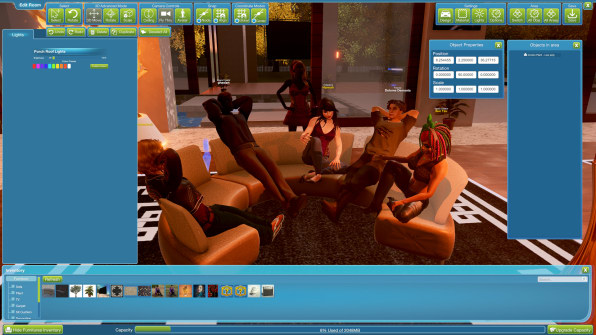For several years, since the release of the Oculus Rift, HTC’s Vive, Samsung’s GearVR, and other headsets, consumer virtual reality has been seen as the future of social 3D worlds.
But while there are numerous social VR projects, such as Facebook Spaces, Altspace, VR Chat, High Fidelity, Sansar, and others, no one has yet cracked the code of building a fully three-dimensional, open-ended, extensible virtual world that can handle many dozens, or even hundreds, of users in a single space. Now, Sinespace, a new metaverse project from an Australian company called Sinewave Entertainment, is seeking to be the first to offer all those features.
While some analysts have predicted that VR will be a $38 billion industry by 2026, the nascent consumer technology has yet to achieve true mainstream adoption–so it’s not clear exactly how many people might be looking to have immersive social VR experiences.
Starting in 2003, graphical virtual worlds like Second Life took the technology world by storm. But while they presented fascinating social, economic, and technological innovations, worlds like Second Life were fundamentally limited–they were 2D, mostly had keyboard-only interfaces, and were often so difficult to learn to use that the vast majority of people who created accounts bailed before spending any meaningful time in-world.


Frisby is someone who should know what success in the metaverse looks like. Sinewave Entertainment developed and ran two of the largest brands in Second Life, each generating annual seven-figure revenues. With Sinespace, he’s hoping that cross-platform functionality and modern technology will lead to user numbers far in excess of the low seven-figure numbers a world like Second Life ever achieved.
Sinespace’s biggest selling point, Frisby says, is that it is built using Unity’s game engine, the most popular in the world. That means that unlike a virtual world like Second Life, which was extremely hard to fundamentally change, Sinespace is modular, and its core functionality can be regularly updated. It’s designed, he says, to be extensible and upgradeable. That alone could help overcome the problems that led so many people to abandon the difficult-to-use Second Life.
Sansar, from Second Life publisher Linden Lab, is probably the best example of another metaverse in VR. And while Sansar is VR-only, it’s also built on a proprietary gaming engine, meaning that it could prove to be harder to upgrade its core technology. That was a problem for Second Life, and it’s something Sinespace is hoping that its Unity foundation will set it apart.
The new metaverse also has interesting features that could make it compelling for social interactions. For example, using any computer’s built-in webcams, Sinespace avatars mirror user’s actual facial expressions, as well as their forward and backward movements.
With its full PC client, Sinespace offers impressive, high-quality graphics–and a demo of the virtual world revealed rich, user-created environments, including attractive architecture and landscapes, as well as somewhat realistic avatars. The system automatically downgrades the graphical quality in the Web client, making it possible to still use the metaverse with low latency–a very important factor in attracting, and keeping, users.


Sinespace has chosen a vetted-content model, meaning that it won’t allow free-for-alls of adult content the way worlds like Second Life did. But Frisby says that content review is quick. As well, he says that users can create anything they want in private, sandbox environments. But anything that goes live and is publicly viewable must meet standards. “The rule of thumb,” he says, “is that if it’s okay to show on MTV, it’s okay.”That means no flying penises in public Sinespace areas.
At the same time, Sinespace’s content creation tools mean that users can create rich interactions–even multi-user games–that other users can play. He says it’s possible, in theory, for someone to build their own version of a game like World of Warcraft within Sinespace.
Now, with Sinespace’s VR support, those with a high-end headset will be able to explore the metaverse in a first-person perspective, controlling their environment with a virtual hand-held tablet. The system does track users’ arms and heads in VR, making it more realistic. And, Frisby says, the system has been built to minimize any kind of nausea. The company knows that a relatively minor number of people will use Sinespace in VR, but clearly, it sees the capability as a bit of future-proofing.
For now, as a recent visit demonstrated, Sinespace is still largely a ghost town. And that can be a problem for new users that arrive hoping to find a thriving social ecosystem. So it’s far too early to tell if this virtual world can blossom. But at its core, it’s built with the cautionary tales of past virtual worlds in mind, and is aiming to avoid repeating the kinds of mistakes that prevented Sinespace’s predecessors from becoming massive hits. In this case, as with all new platforms, only time will tell. But one thing’s clear: It’s good to see someone attempting an extensible, easy to upgrade, VR-ready virtual world.
This article was originally published by Fast Company.

